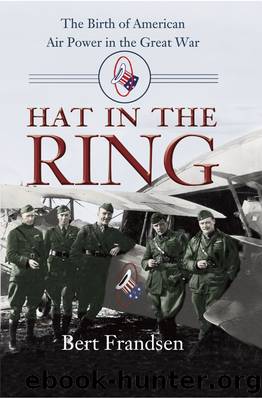Hat in the Ring by Bert Frandsen

Author:Bert Frandsen [Frandsen, Bert]
Language: eng
Format: epub
ISBN: 978-1-58834-458-8
Publisher: Smithsonian
Published: 2013-01-21T16:00:00+00:00
The air cover was so good, Haslett remarked, that the attack on Vaux seemed like a training exercise.35
It did not seem like a training exercise to Lt. Harold Tittman, a pilot who had recently joined the 94th Aero Squadron. Tittman was flying in the upper-left position of a V formation of six airplanes, led by Jimmy Meissner, that had taken off from Touquin at three in the afternoon and penetrated deep into German airspace. As they flew south from Soissons their route took them close by the bases of JGs 1 and 3. A group of seven German fighters attacked Meissner’s patrol from the sun-drenched western skies, achieving complete surprise. Meissner identified them as Fokker D-7s. “The first thing I knew about their presence,” Tittman recalled, “were the tracer-bullets passing in front of me. I remember seeing one of the German planes headed directly toward me and it came so close that I could even distinguish the pilot’s black moustache!”36
Anxious to get on the German’s tail and shoot him down, Tittman left his patrol—the worst thing he could have done, he later realized. Finding himself suddenly alone, he tried to make his way back toward friendly territory, but five enemy fighters jumped him. Tittman was shot through the right lung, right arm, and right foot and crash-landed. Two hundred bullet holes were found in his airplane. His worst injuries, though, were caused by the crash itself, which he barely survived: he lost his left leg and spent the next twenty-two months in the hospital.37
Lt. Waldo Heinrichs of the 95th Aero Squadron was in the air for his second patrol that day as H-hour approached. His patrol of six airplanes had taken off at half past four that afternoon, but because of “wretched leading” by the flight leader, Lt. Sumner Sewall, the formation had broken up, and Heinrichs found himself in a patrol of only three airplanes. Even at this altitude, the artillery fire on Vaux, more than eleven thousand feet below him, was so intense it threw clouds of smoke and dust up to the altitude of his patrol. He noted in his diary that it was “desperately dangerous as Boche came over in droves of 12, 18, and 20. In fact 50, in 3 formations crossed our lines before 8 A.M. this day.”38
Enemy aircraft were not encountered at the lowest altitudes of pursuit coverage during the attack. Quentin Roosevelt, also of the 95th Squadron, was airborne at the same time as Heinrichs but was flying three thousand feet closer to the ground. “We were scheduled to fly on the low level, at twenty-five hundred meters [8,200 feet],” he wrote home the next day, “to intercept any enemy photographers or reglage [artillery-adjusting] planes. There were two more patrols above us, one around four thousand and one up along the ceiling, keeping off their chasse planes. We didn’t run into any of their planes.” When Roosevelt returned to Touquin he found out that the top flight had been engaged in a fight with nine Fokkers.
Download
This site does not store any files on its server. We only index and link to content provided by other sites. Please contact the content providers to delete copyright contents if any and email us, we'll remove relevant links or contents immediately.
| Africa | Americas |
| Arctic & Antarctica | Asia |
| Australia & Oceania | Europe |
| Middle East | Russia |
| United States | World |
| Ancient Civilizations | Military |
| Historical Study & Educational Resources |
Before Topgun Days: The Making of a Jet Fighter Instructor by Dave Baranek(793)
Enemy Coast Ahead by Guy Gibson(685)
The SAS Training Manual by Chris McNab;(673)
The True Story of Catch 22 by Patricia Chapman Meder(587)
Comet! The World’s First Jet Airliner by Graham Simons(581)
Outlaws Inc. by Matt Potter(563)
Airborne by Tom Clancy(526)
The Other Side of Airfix by Authur Ward(525)
The Wright Company by Edward J. Roach(522)
Memoirs of a Stuka Pilot by Helmut Mahlke(508)
Beyond Band of Brothers by Richard D. Winters(500)
Hitler's Eagles by Chris McNab(494)
Air Warriors by Douglas Waller(463)
Boyd by Robert Coram(457)
Stormchasers by David Toomey(449)
Pegasus, The Heart of the Harrier: The History and Development of the World's First Operational Vertical Take-off and Landing Jet Engine by Andrew Dow(448)
Airborne (1997) by Clancy Tom(444)
Focke-Wulf Fw 190 by CHRIS GOSS(423)
I Always Wanted to Fly by Wolfgang W. E. Samuel(409)
